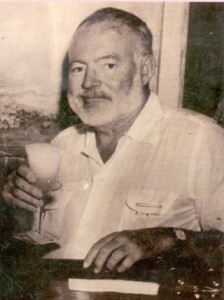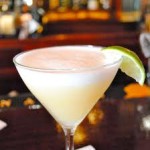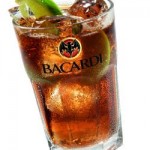Talking about all Cuban cocktails is impossible since our variety of cocktails are very wide.
Alejo Carpentier said many years ago when he said that Havana was the largest city in the world that could offer variety of drinks curious traveler’s palate. We, in our pilgrimage through bars and taverns, as the famous bolero who played Orlando Contreras, came to collect more than three hundred recipes for cocktails. He had from all over the country: from Havana, especially, but also of Baracoa and Viñales because if anything is proudly and this scribbler is proud to have crossed Cuba, and many of its keys-from beginning to end. But the formulas are certainly many more; Floridita’s computer, which is one of the most famous bars in the world, had a few years ago about 450. And they were not all.
Sure it endorses a cocktail time. Surge in any bar and is imposed or not preference drinkers. Thus, there are Cuban cocktails that nobody remembers or dislike remember though, while others become popular and go around the world. The taste of good drinker is, in this, particularly wise.
When speaking of the great Cuban cocktails, refers to Saoco, the Mulata, the Mary Pickfords, the President and the Mojito. And also the Cuba Libre, to Santiago, the Isle of Pines and of course, the Daiquiri, who is the king of Cuban cocktails. This is recognized by specialists.
Bartenders famous in Cuba there are also many people who made their craft an art. The relationship, in this line, is led undoubtedly Ribalaigua Constantine, the owner of Floridita, the constant Islands in the Stream, Hemingway’s novel. Born in Spain, Cuba nationalized and died in Havana in 1952. He is the creator of Mary Pickfords, inspired by the American actress known as “America’s Sweetheart”-American bride would then another over our, Libertad Lamarque, and the Havana Special, which took its name from a shipping line whose ships were the crossing between Tampa and Havana. Constant also is associated with the Daiquiri and the President, but not created.
CRAZY ABOUT DAIQUIRI
The President – surprise! – Was the brainchild of Major General Mario García Menocal. The president then came one afternoon and asked to Floridita Constant a mixing bowl put ice drops curacao, vermouth and rum carte Italian white gold. He said he writhes and serve it in a tall glass, baccarat, garnished with a cherry and a slice of orange peel. Constant said then: “General, here’s your President.”
Some say that initially called Canchánchara Daiquiri, the drink of choice for Cuban independence forces. Our liberators, when they could, the tasted sweetened with honey to ward off the pains, aches and fatigue. But in truth the Daiquiri was born in the iron mines of the same name east of the country, and was popularized in the Venus Hotel, Santiago de Cuba, the former Hotel Venus, which was opposite the park lawns and collapsed when the 1932 earthquake.
The Hotel Venus, however, the Daiquiri was preparing to direction, no exact measurements as the inspiration of the bartender, and cooled with ice chips. It was constant, then, in the Floridita, who established the precise standard of this cocktail.
Began to cool with ice frappe and found that it does not tolerate drink half ounces of rum if you take less, the blender protest, if you take more, is watery. Also discovered that you could not leave the mixer over a minute and realized the taste finally giving it the maraschino.
Hemingway Daiquiri immortalized in his narrative. Other important writers have either overlooked in their texts and in their lives. Garcia Marquez, Nobel Prize for Literature as Hemingway Daiquiri refers to as “a combination of rum diaphanous Island ice powder and lemon juice.” And another Nobel, but rejected the award, Jean Paul Sartre, in his Hurricane on sugar, the exciting story he wrote about Cuba in 1960, mentions him as “a Cuban specialty we like the mild taste of his rum and lemon diluted in ice. ”


Graham Greene, which won the Nobel Prize ten times but never give it to him, and was, in the words of García Márquez, an inventor of evil cocktails, tasted it, and how, during his stay in Havana. García Lorca was enthusiastic about the Floridita Daiquiri. Lezama Lima recalled the day he accompanied Miguel Angel Asturias, the Guatemalan novelist remarkable Nobel Prize in addition, to this famous bar-restaurant. We delight, asserted the author of Paradiso, with that frozen drink that is like the nectar of the gods. The Argentine Julio Cortázar had him as the first in what refers to Cuban cocktails. So he confessed to the author of this page that drank his first daiquiri in company always pleasant and stimulating Hopscotch novelist.
FRANCIS DRAKE AND THE MOJITO
The Saoco, surely, has peasant origins. Only in the Cuban countryside could have arisen that magical mix of white rum and coconut water. The Free Cuba was born in the Floridita, when that bar is still called La Piña de Plata, in the days of the establishment of the Republic (1902). The Isle of Pines includes in its formula that wonder juice Cuban fruit is grapefruit. And Santiago is prepared with two lines of white rum and red curacao stroke. The Mulata had to have been created by a Spanish barman. Pays tribute like no to the beauty and distinction of the Cuban. It is made with rum, which adds a unique superiority.
And the Mojito? Ferdinand claimed G. Campoamor, historian of rum, the British privateer Francis Drake is the creator of a cocktail until well into the nineteenth century was much in demand in the West Indian latitudes. It was made with brandy and called Drake. He is said healing properties. At least in his novel The anger in Havana (1838) Ramon de Palma does tell one of his characters: “I take every day at eleven and one draquecito going perfectly”. Is the antecedent of the Mojito.
Since 1910 Mojito discussion began churning, but would have to wait for the decade of the 30 for the appearance of the current Mojito. Surge in the bar of La Concha Spa, passes to other bars Havana, becomes popular and gets to La Bodeguita del Medio, where he acquired international citizenship card. It has the poise of the Daiquiri and the packaging of the President or the baroque of Mary Pickfords and the haughtiness of Mulata, but is one of the ten classic Cuban cocktails next to Saoco, the Isle of Pines, the Santiago, the Havana Special and the Cuba Libre.
Sources:CiroBianchiRoss/InternetPhotos/www.theCubanhistory.com
LET’S TALK OF THE CUBAN COCKTAILS
The Cuban History, Arnoldo Varona, Editor
HABLEMOS DE LOS COCTELES CUBANOS
Hablar sobre todos los cocteles cubanos es imposible ya que nuestra coctelería es muy numerosa y variada.
Alejo Carpentier lo dijo hace ya muchos años cuando afirmó que La Habana era la ciudad del mundo que mayor variedad de bebidas podía ofrecer al paladar curioso del viajero. Nosotros, en nuestro peregrinar por bares y cantinas, como dice el célebre bolero que interpretaba Orlando Contreras, llegó a acopiar más de trescientas recetas de cocteles. Las había de todas partes del país: de La Habana, sobre todo, pero también de Baracoa y Viñales porque si de algo se precia y enorgullece este escribidor es de haber recorrido Cuba –y muchos de sus cayos- de punta a cabo. Pero las fórmulas son ciertamente muchas más; en la computadora del Floridita, que es uno de los bares más famosos del mundo, había hace ya algunos años más unas 450. Y no eran todas.
Claro que a un coctel lo refrenda el tiempo. Surge en cualquier bar y se impone o no en la preferencia de los bebedores. Así, hay cocteles cubanos que nadie recuerda o que aunque se recuerden no gustan, mientras que otros se popularizan y dan la vuelta al mundo. El gusto del buen bebedor es, en esto, particularmente sabio.
Cuando se habla de los grandes cocteles cubanos, se alude al Saoco, al Mulata, al Mary Pickfords, al Presidente y al Mojito. Y también al Cuba Libre, al Santiago, al Isla de Pinos y, por supuesto, al Daiquirí, que es el rey de los cocteles cubanos. Así lo reconocen los especialistas.
Cantineros ilustres hay también muchos en Cuba, gente que hizo de su oficio un arte. La relación, en esta línea, la encabeza, sin duda, Constantino Ribalaigua, el propietario del Floridita, el Constante de Islas en el golfo, la novela de Hemingway. Nació en España, se nacionalizó cubano y falleció en La Habana en 1952. Es el creador del Mary Pickfords, inspirado en la actriz norteamericana conocida como “la novia de América” –América tendría después otra novia más nuestra, Libertad Lamarque-, y el Havana Special, que tomó su nombre del de una línea naviera cuyos barcos hacían la travesía entre Tampa y la capital cubana. Constante asimismo se asocia al Daiquirí y al Presidente, aunque no los creara.
LOCOS POR EL DAIQUIRÍ
El Presidente -¡asombro!- fue idea del mayor general Mario García Menocal. El entonces primer mandatario llegó una tarde al Floridita y pidió a Constante que en un vaso de mezcla pusiera hielo, gotas de curazao, vermut blanco italiano y ron carta oro. Dijo que lo revolviera y se lo sirviera en una copa alta, de bacarat, adornada con una guinda y un pedacito de cáscara de naranja. Constante comentó entonces: “General, aquí tiene su Presidente”.
Hay quien dice que en sus inicios el Daiquirí se llamó Canchánchara, la bebida preferida por las tropas independentistas cubanas. Nuestros libertadores, cuando podían, la degustaban endulzada con miel de abeja para alejar las penas, los dolores y la fatiga. Pero en verdad el Daiquirí nació en las minas de hierro del mismo nombre del oriente del país, y se popularizó en el hotel Venus, de Santiago de Cuba; el antiguo hotel Venus, el que se hallaba frente al parque Céspedes y se derrumbó cuando el terremoto de 1932.
En el hotel Venus, sin embargo, el Daiquirí se preparaba al rumbo, sin medidas exactas, según la inspiración del cantinero, y se enfriaba con trozos de hielo. Fue Constante, entonces, en el Floridita, quien estableció la norma precisa de este coctel.
Comenzó a enfriarlo con hielo frapé y descubrió que el trago no tolera sino onza y media de ron; si se le echa menos, la batidora protesta, si se le echa más, queda aguado. Descubrió asimismo que no se podía dejar en la batidora más de un minuto y se percató por último del sabor que le confería el marrasquino.
Hemingway inmortalizó el Daiquirí en su narrativa. Otros escritores importantes tampoco lo han pasado por alto en sus textos y en sus vidas. García Márquez, Premio Nobel de Literatura al igual que Hemingway, se refiere al Daiquirí como “una combinación de ron diáfano de la Isla con polvo de hielo y jugo de limón”. Y otro Nobel, aunque rechazara el galardón, Jean Paul Sartre, en su Huracán sobre el azúcar, el apasionante reportaje que escribió sobre Cuba en 1960, lo menciona como “una especialidad cubana que nos agrada por el leve gusto a ron y de su limón diluido en hielo”.
Graham Greene, que mereció diez veces el Premio Nobel aunque nunca se lo dieran, y que fue, al decir de García Márquez, un inventor de cocteles diabólicos, lo degustaba, y de qué manera, durante sus estancias en La Habana. García Lorca se entusiasmó con el Daiquirí del Floridita. Lezama Lima rememoraba el día en que acompañó a Miguel Ángel Asturias, el notable novelista guatemalteco y Premio Nobel por añadidura, a ese afamado bar-restaurante. Nos deleitamos, aseveraba el autor de Paradiso, con aquella bebida helada que es como el néctar de los dioses. El argentino Julio Cortázar lo tenía como el primero en lo que a cocteles cubanos se refiere. Así lo confesó al autor de esta página que bebió su primer Daiquirí en la compañía siempre grata y estimulante del novelista de Rayuela.
FRANCIS DRAKE Y EL MOJITO
El Saoco, de seguro, tiene origen campesino. Solo en el campo cubano pudo haber surgido esa mezcla mágica de ron blanco y agua de coco. El Cuba Libre nació en el Floridita, cuando todavía ese bar se llamaba La Piña de Plata, en los días de la instauración de la República (1902). El Isla de Pinos incluye en su fórmula el zumo de esa maravilla de las frutas cubanas que es la toronja. Y el Santiago se prepara con dos líneas de ron blanco y un golpe de curazao rojo. El Mulata tuvo que haber sido creado por un barman español. Rinde tributo como pocos a la belleza y distinción de la cubana. Se elabora con ron añejo, lo que le da un toque de superioridad único.
¿Y el Mojito? Aseguraba don Fernando G. Campoamor, historiador del ron, que el corsario británico Francis Drake es el creador de un coctel que hasta bien entrado el siglo XIX fue muy demandado en las latitudes antillanas. Se elaboraba con aguardiente y se llamaba Drake. Tenía, se dice, propiedades curativas. Al menos en su novela El cólera en La Habana (1838) Ramón de Palma hace decir a uno de sus personajes: “Yo me tomo todos los días a las once un draquecito y me va perfectamente”. Es el antecedente del Mojito.
Desde 1910 comienza a hablarse del Mojito batido, pero habría que esperar a la década de los 30 para que apareciera el Mojito actual. Surge en el bar del balneario de La Concha, pasa a otros bares habaneros, se populariza y llega a La Bodeguita del Medio, donde adquiere carta de ciudadanía internacional. No tiene la prestancia del Daiquirí ni el empaque del Presidente ni el barroquismo del Mary Pickfords ni la altanería del Mulata, pero es uno de los diez clásicos de la coctelería cubana junto al Saoco, el Isla de Pinos, el Santiago, el Havana Special y el Cuba Libre.
Sources:CiroBianchiRoss/InternetPhotos/www.theCubanhistory.com
LET’S TALK OF THE CUBAN COCKTAILS
The Cuban History, Arnoldo Varona, Editor







